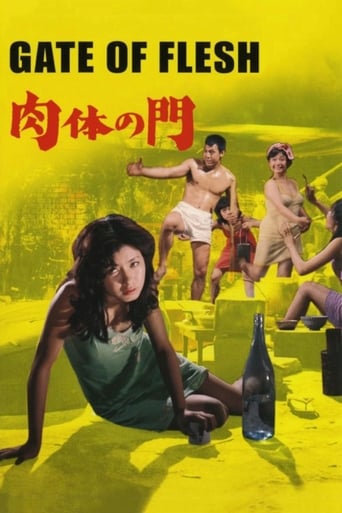shishido
Yet another brilliant work from director Suzuki Seijun, who manages to create (in almost every frame) a world in which lurid pulp paperback cover paintings have come to life! This tale of the rampant desperation of mere existence in post-WWII Tokyo is simply stunning on all counts. "Nikutai no Mon" ("Gate of Flesh") is both bleakly realistic, and flamboyantly artistic. It is brutal, shocking, funny, and depressing--sometimes all at once! Excellent cinema--not to be missed by any Japanese film buffs.
elihu-2
Born on May 24, 1923, Seijun Suzuki was a trade school drop-out and a soldier before studying film at Kamakura academy. After graduating in 1948, he was employed at Ofuna Studio as an assistant director. He began his full-fledged directing career at Nikkatsu in 1954, where he subsequently made 40 films. Most of these were quickie crime thrillers which were akin to Hollywood B-movies. Within the constricting confines of the mercenary studio system, Suzuki was nonetheless able to find his own unique creative sensibility.His earliest films bear a renegade, sensual flair and a vibrant visual style unsurpassed by more recent work in both the West and Asia. Working in Cinemascope, he used the widescreen frame to full effect, composing intricate shots which seem almost three dimensional, due to somewhat elaborate staging and the novel device of using dissolves to show characters and action on the opposite side of the room or space to which the main camera is pointing.GATE OF FLESH (1964) exemplifies this. One of Suzuki's most atypical films, it tells the tale of a pimp-less group of hellcat prostitutes trying to survive in the chaotic, crime-ridden arena of post-war Tokyo. Living by a strict code, any of their number can be severely physically punished for sleeping with a man for free. Puffy-cheeked Suzuki regular Jo Shishido plays Shintaro Ibuki, a macho renegade former soldier who deals on the black market and comes to lord it over the band of women. Captivating each of them, he causes a rift among them in which the young novice hooker Maya suffers the most, as she is totally enamored of him. The film is intensely visceral, outrageous, and risque, even today. It must have been positively explosive in 1964, with its sweating, erotically-driven characters, fairly explicit depictions of sex, and savage scenes in which naked women are tied up and whipped by other women. The aggressive sensuality is further enhanced by the Fujicolor processing, which accentuates the reds and greens.Due to his interpid nonconformism, Suzuki was fired from Nikkatsu in 1968. Amid shake-ups and financial problems at the studio, the suits decided to jettison him for making "incomprehensible" films. This prompted a massive movement on his behalf organized by his fans of time, who were mostly college students. With their support, as well as that of the Director's Guild of Japan, Suzuki filed a court case for wrongful dismissal. He won the case, but the resulting furor got him blacklisted out of the studio system, and Suzuki was only able to resume making feature films in 1977, albeit independently.
freakus
Suzuki is the master! He has made the greatest examples of 60's low budget exploitation cinema. The way he uses a different color to represent each of the prostitutes almost makes them appear like demons in that underground lair of theirs. But who is the real monster of the film? The occupying Americans who use the prostitutes? The prostitutes themselves? Or is it the hate filled ex-soldier (played by the great Joe Shishido!) who controls the women?
denwa
A jump and you meeting like in a film of Oshima or Mizogouchi. Nikutai Mon (1964) can not be seen like a scandal or like a true masterpiece. The personage, nearly a samurai bankrupt, played by the hounded man is exemplar in order to understand like Japan same changing, in the forecasts of Mishima, worse. For being more clear I will say Japan in free fall. An example is the here impotent police while in group the young people kill and stole. Under this optical the worlds formed from this man and these three women is parallel, peculiar, sadist. Turned always holding the cinema camera to level of the human eye: Nikutai not Mon (1964) a little reassuring neorealism, the land rendered fertile from the tragedy of Seppuku, directed from Kobayashi time before. Now Japanese cinema has nothing more to say while collects the fragments of its tradition.



